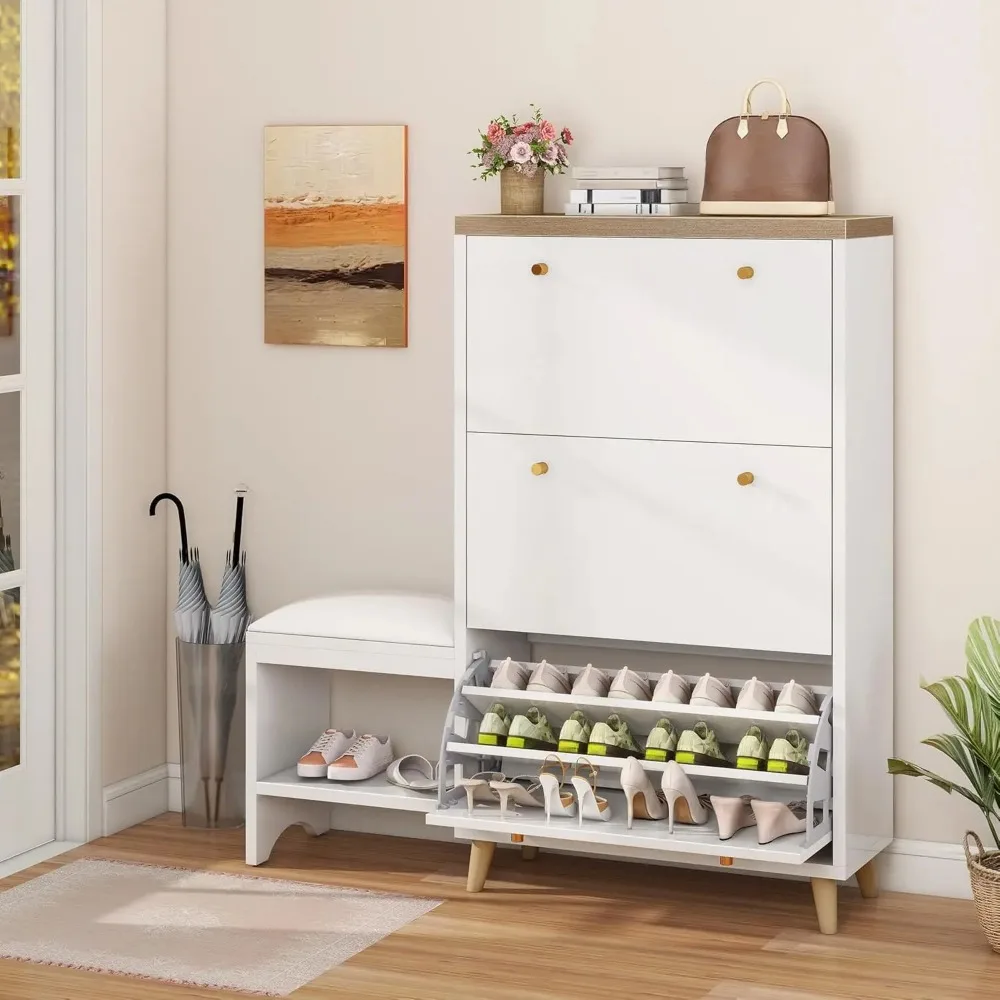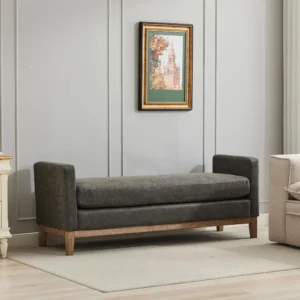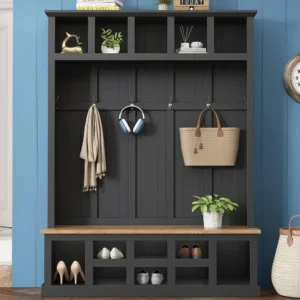Understanding the Importance of a Hall Tree Bench
The entryway of your home sets the first impression for visitors and welcomes you back each day. At the heart of many well-designed entryways is a hall tree bench—a multifunctional piece that combines seating, storage, and organization in one elegant solution. This versatile furniture piece serves as the foundation of your entryway, providing not just a place to sit while putting on or removing shoes, but also creating a designated space for everyday essentials.
A properly selected hall tree bench delivers multiple benefits:
- Practical functionality: Creates a dedicated spot for daily transitions—removing shoes, setting down bags, or sorting mail
- Enhanced organization: Reduces clutter by providing specific storage areas for shoes, bags, accessories, and seasonal items
- Visual appeal: Establishes a welcoming focal point that sets the tone for your home’s overall style
- Space efficiency: Maximizes vertical and horizontal space in what’s typically a limited area
Research suggests that well-organized entryways can save the average household up to 15 minutes daily in searching for items, amounting to nearly 90 hours annually. Beyond the practical benefits, having an orderly entryway has psychological advantages—reducing stress and creating a sense of calm when entering or leaving your home.
The right space-saving benches for entryways can transform how you use this transitional space. Whether you’re considering upgrading your current setup or starting fresh, understanding the importance of selecting the proper bench for your hall tree coat rack will guide you toward making an informed decision that balances both style and function.
Measuring Your Space: Finding the Perfect Fit
Before falling in love with a particular hall tree bench style, it’s essential to understand your space constraints. Proper measurements ensure your new furniture piece will fit comfortably without crowding your entryway.
Follow these measurement steps for optimal results:
- Measure the total width and depth of your intended placement area
- Allow a minimum of 36 inches (91 cm) of clearance for walkways
- Account for door swing radius—doors should open completely without obstruction
- Consider ceiling height if your hall tree includes vertical components
- Map traffic patterns to ensure the bench doesn’t create bottlenecks
Standard hall tree bench dimensions typically include:
- Height: 18-20 inches (45-51 cm) from floor to seat
- Depth: 15-20 inches (38-51 cm) for comfortable sitting
- Width: Varies based on design, from 24-60 inches (61-152 cm)
When measuring, remember that the bench should be proportional to your hall tree component. A massive hall tree paired with a tiny bench creates visual imbalance, while an oversized bench in a small entryway can make the space feel cramped and unwelcoming.
For those with limited square footage, smart entryway bench solutions can help you maximize functionality without sacrificing style. Consider the overall proportion of your entryway when selecting dimensions—tall, narrow entryways might benefit from a slimmer profile, while wider spaces can accommodate more substantial pieces.
If you’re working with an especially tight space, exploring narrow bench options designed specifically for smaller entryways can help you find furniture that fits perfectly while still providing essential functionality.
Bench Materials: Durability Meets Design
The material of your hall tree bench significantly impacts its durability, maintenance requirements, and overall aesthetic. Since entryways endure heavy traffic and exposure to the elements, selecting the right material is crucial for long-term satisfaction.
Solid Wood
Solid wood remains a popular choice for its natural beauty, strength, and timeless appeal. Each wood type offers distinct characteristics:
- Oak: Exceptional durability with prominent grain patterns; withstands heavy use
- Maple: Dense, scratch-resistant surface with a subtle grain; excellent for high-traffic areas
- Pine: More affordable option with a casual, rustic look; may show wear more readily
- Walnut: Rich, dark tones that create a sophisticated appearance; moderately durable
Wood benches require occasional conditioning and should be protected from excessive moisture, especially in entryways exposed to outdoor elements.
Engineered Wood
Manufactured wood products offer budget-friendly alternatives while maintaining attractive appearances:
- More stable in fluctuating humidity conditions than solid wood
- Available in various finishes that mimic premium wood species
- Generally lighter weight and easier to assemble
- Less durable than solid wood but sufficient for moderate use
Metal Components
Metal elements add both structural integrity and style:
- Steel frames: Provide exceptional strength in slim profiles
- Wrought iron: Offers ornate detailing for traditional or rustic styles
- Aluminum: Lightweight and resistant to corrosion, ideal for humid climates
Upholstered Options
Fabric or leather seating surfaces add comfort and style:
- Performance fabrics: Resist stains, moisture, and fading—ideal for busy households
- Leather/faux leather: Easy to wipe clean and develops character over time
- Removable cushions: Offer cleaning convenience and opportunity to change styles
The material you choose should reflect both your aesthetic preferences and practical needs. For example, a household with young children might prioritize easy-clean surfaces like leather or vinyl, while someone seeking warmth and character might prefer solid wood entryway bench options with rich grain patterns.
Seating Comfort: Ergonomics and Daily Use
While entryway benches aren’t typically designed for extended sitting periods, comfort remains an important consideration for those moments when you’re putting on shoes or setting down packages. A bench that’s uncomfortable won’t get used, defeating its purpose in your entryway.
Key comfort factors to consider include:
- Height: The optimal bench height of 18-20 inches (45-51 cm) allows most adults to sit with feet flat on the floor
- Depth: A depth of 15-18 inches (38-46 cm) provides adequate support without forcing users to sit too far from the edge
- Surface: The seat surface should be smooth and free from uncomfortable protrusions
- Edge design: Slightly rounded front edges reduce pressure on the back of thighs
For enhanced comfort, consider cushion options:
- High-density foam: Offers support without excessive sinking
- Memory foam: Contours to body shape for personalized comfort
- Fiber fill: Provides a softer feel but may compress over time
When selecting cushioning, consider the balance between comfort and practicality. Thicker cushions provide more comfort but may reduce the overall seating height. Additionally, understanding the perfect entryway bench height for your household members ensures the bench works well for everyone who uses it.
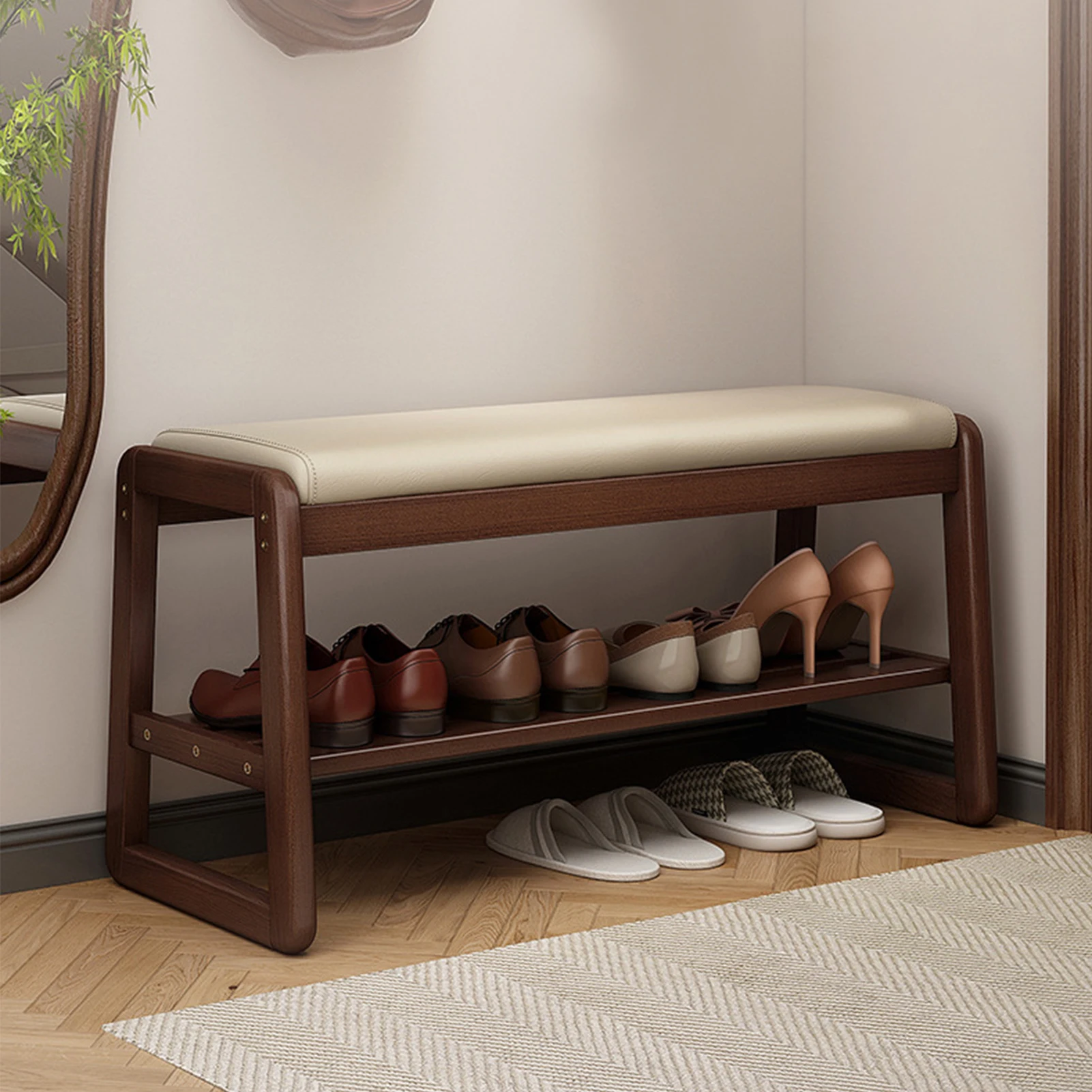
For those prioritizing comfort, cushioned bench options provide added softness while maintaining functionality. Consider removable cushions that allow for easy cleaning and seasonal style changes—a particularly valuable feature for entryway furniture that encounters outdoor elements.
Storage Solutions: Organizing Your Entryway
The right storage configuration transforms a simple bench into a powerful organization tool for your entryway. Different storage designs address specific needs and item types, making it important to consider what you’ll actually be storing.
Common storage configurations include:
Storage Type Comparison
| Storage Type | Best For | Capacity | Accessibility |
|---|---|---|---|
| Lift-top bench | Hidden storage, larger items | High | Moderate (requires lifting) |
| Open cubbies | Shoes, baskets, quick access items | Moderate | High (always visible) |
| Drawers | Small accessories, private items | Moderate | Moderate (requires pulling out) |
| Shelves | Display items, frequently used accessories | Low-Moderate | High (always visible) |
When evaluating storage options, consider:
- Household size: Larger families typically need more compartmentalized storage
- Seasonal needs: Will you need to store winter accessories in summer months?
- Visibility preferences: Do you prefer items hidden away or easily accessible?
- Item types: Shoes require different storage solutions than mail or keys
Effective entryway organization isn’t just about having storage—it’s about having the right kind of storage. Organizing strategies for entryway benches can help you maximize whatever configuration you choose, ensuring everything has a designated place.
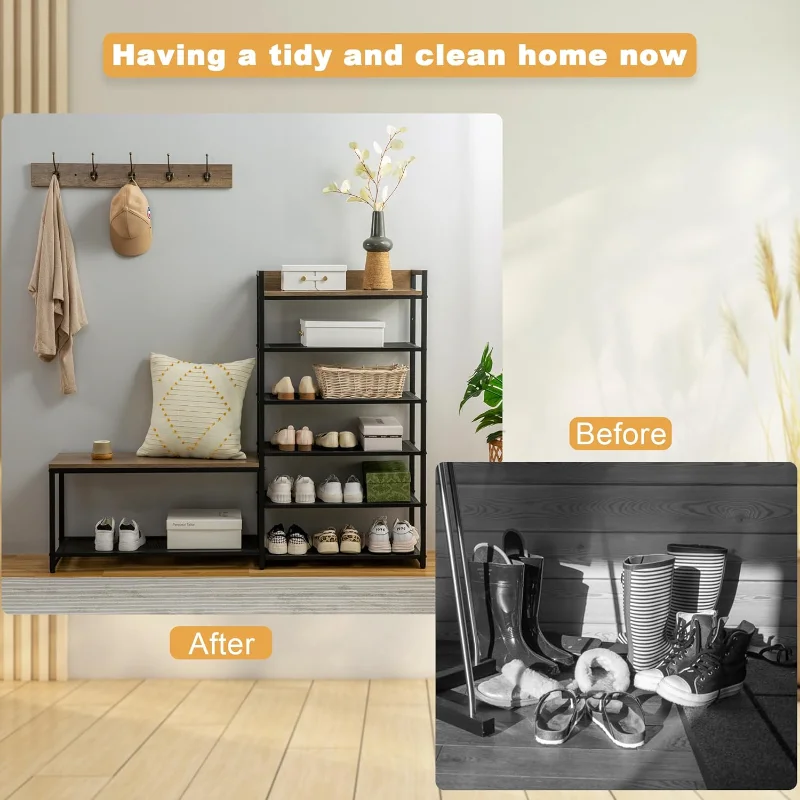
For households needing substantial storage, exploring dedicated storage bench options can provide solutions that balance seating with organization. Consider combinations of storage types—perhaps open cubbies for shoes with a drawer for smaller items—to create a versatile system that addresses all your entryway needs.
Entryway Bench with Cushion, Mudroom Bench with Cushion, Shoe Bench for Entryway
$1,186.63 Select options This product has multiple variants. The options may be chosen on the product pageCoat Rack Shoe Bench, Corner Entryway Bench, Corner Hall Tree, Shoe Bench for Entryway
$313.58 Select options This product has multiple variants. The options may be chosen on the product pageCorner Entryway Bench, Entryway Bench with Cushion, Modern Entryway Bench, Shoe Bench for Entryway
$476.34 Select options This product has multiple variants. The options may be chosen on the product pageBench with Hooks and Storage, Entryway Hall Tree, Mudroom Bench with Cubbies, Mudroom Bench with Shoe Storage
$818.38 Select options This product has multiple variants. The options may be chosen on the product pageModern Entryway Bench, Wood Entryway Bench, Wood Mudroom Bench
$497.69 Select options This product has multiple variants. The options may be chosen on the product pageEntryway Coat Rack Bench, Entryway Hall Tree, Farmhouse Mudroom Bench, Mudroom Bench with Shoe Storage
$805.09 Select options This product has multiple variants. The options may be chosen on the product page
Style and Aesthetics: Matching Your Home’s Design
Your hall tree bench makes a strong visual statement in your entryway, making style alignment with your home’s overall aesthetic particularly important. The best bench choices complement existing décor while creating a welcoming first impression.
Popular style categories include:
- Farmhouse: Characterized by distressed finishes, natural wood tones, and simple hardware—creates a warm, inviting atmosphere
- Modern: Features clean lines, minimal ornamentation, and often incorporates mixed materials like wood with metal accents
- Industrial: Combines raw materials like metal and distressed wood with utilitarian design elements
- Traditional: Includes more ornate details, curved elements, and classic silhouettes
- Transitional: Blends traditional and contemporary elements for versatile appeal
When selecting a style, consider:
- The architectural character of your home
- Existing furniture styles throughout your house
- The atmosphere you want to create in your entryway
- Hardware finishes that complement other elements (doorknobs, light fixtures)
Color selection also significantly impacts your bench’s integration with your home’s design scheme. Natural wood tones offer timeless appeal, while painted finishes can add personality or tie into specific color themes. For maximum versatility, consider neutral colors for the bench structure with more colorful accessories that can be changed seasonally.
Exploring various hall tree bench design styles can help you identify which aesthetic direction best suits your home. For those drawn to rustic warmth, farmhouse style options provide that perfect balance of charm and functionality that has made this style enduringly popular.
Special Circumstances: Solutions for Challenging Spaces
Not all entryways are created equal, and many homes present unique challenges that require creative solutions. Addressing these special circumstances can transform even the most difficult spaces into functional, welcoming entryways.
Small Entryways
Limited space doesn’t mean limiting functionality:
- Wall-mounted hall trees with fold-down bench components save floor space
- Narrow benches (12-14 inches/30-36 cm deep) provide seating without protruding too far
- Corner designs utilize often-wasted angular spaces
- Vertical storage maximizes wall space while minimizing footprint
High-Traffic Households
For busy homes with multiple users:
- Select more durable materials like metal frames with solid wood seats
- Choose designs with individual cubbies to separate items by family member
- Look for reinforced construction with higher weight capacities
- Consider benches with easily cleanable surfaces
Multi-Functional Needs
When your entryway must serve multiple purposes:
- Bench designs with hidden storage compartments maximize utility
- Modular components allow for reconfiguration as needs change
- Extendable or nesting options provide flexibility for occasional use
- Consider pieces that can transition to other rooms if needed
Accessibility Considerations
For households with mobility concerns:
- Select benches with 19-21 inch (48-53 cm) height for easier transitions
- Choose sturdy designs with solid armrests for support when sitting/standing
- Ensure storage is accessible without excessive bending
- Allow wider clearances (42+ inches/107+ cm) for mobility device access
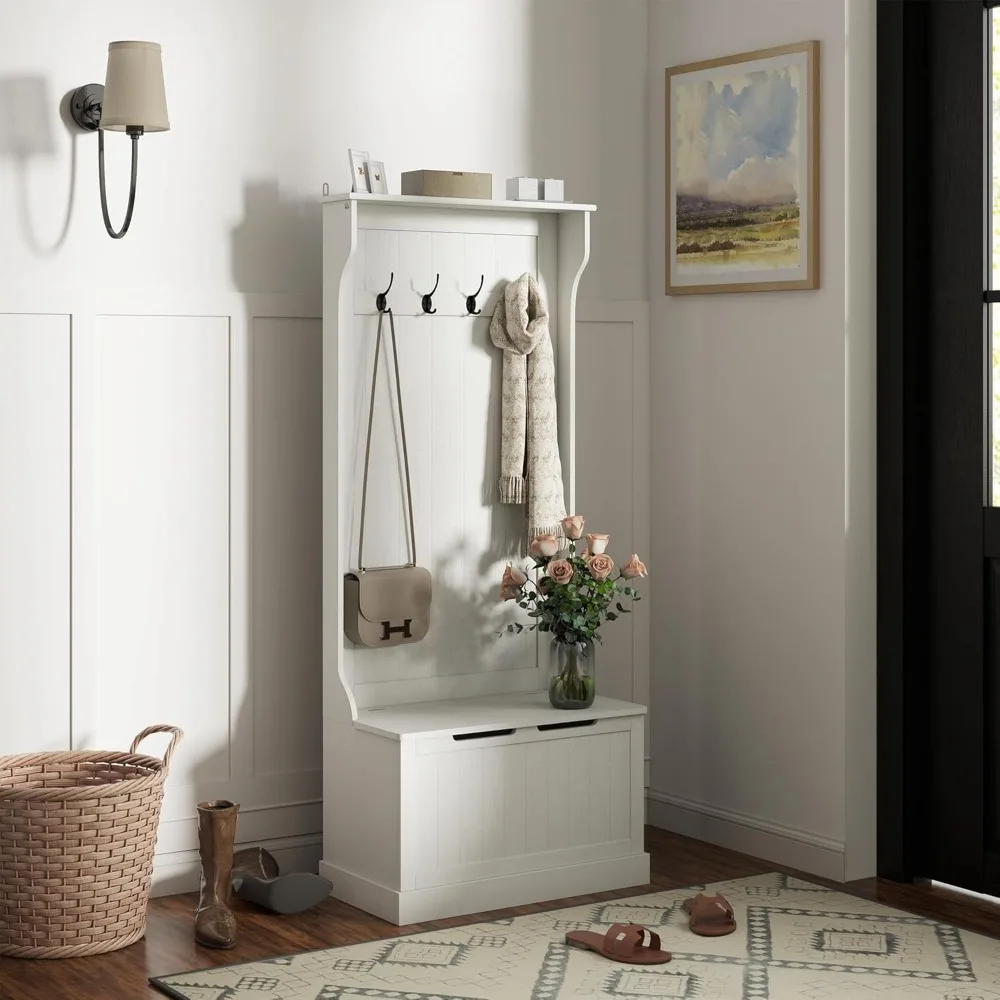
Implementing creative space-saving entryway ideas can help you overcome spatial limitations while maintaining functionality. For particularly challenging entryway configurations, specialized corner hall tree solutions can transform awkward angles into highly functional organization centers.
Budget Considerations: Value vs. Investment
Hall tree benches vary widely in price, making it important to understand where your money goes and how to allocate your budget effectively. Finding the right balance between affordability and quality ensures you get a piece that meets your needs without unnecessary expense.
General price ranges to expect:
- Entry-level ($100-300): Typically engineered wood construction, basic storage features, limited warranty
- Mid-range ($300-700): Solid wood components, better hardware, more storage configurations, extended warranties
- Premium ($700+): All solid wood construction, premium hardware, customizable features, lifetime warranties
When evaluating price points, consider these value factors:
- Construction methods: Mortise and tenon or dovetail joints indicate quality craftsmanship
- Material thickness: Thicker wood components generally offer better durability
- Hardware quality: Soft-close hinges, full-extension drawer glides, and solid metal hardware justify higher costs
- Weight capacity: Higher capacities generally indicate stronger construction
Areas where spending more typically pays off:
- Primary structural components (frame, seating surface)
- Quality joinery and hardware that affect daily use
- Materials in high-contact areas
Areas where you can potentially save:
- Decorative elements that don’t impact structural integrity
- Features you realistically won’t use regularly
- Trendy design elements that might look dated quickly
For those working with limited budgets, affordable entryway bench solutions can provide guidance on getting the most value for your investment. Remember that the true value extends beyond the initial price—a well-made bench can serve your family for decades, while a poorly made one might need replacement within a few years.
Cleaning and Maintenance: Keeping Your Bench Looking New
Entryway furniture faces unique challenges—outdoor elements, heavy traffic, and frequent use all contribute to wear. Establishing proper cleaning and maintenance routines extends your bench’s life and preserves its appearance.
Material-specific care guidelines:
Solid Wood
– Dust weekly with a soft, dry cloth
– Clean spills immediately with a slightly damp cloth
– Apply wood conditioner or polish quarterly
– Keep away from direct sunlight and heating vents
– Maintain consistent humidity levels when possible
Upholstered Surfaces
– Vacuum regularly using upholstery attachment
– Treat spills immediately with appropriate cleaners
– Apply fabric protector annually
– Rotate or flip cushions monthly if removable
– Follow manufacturer’s recommendations for deep cleaning
Metal Components
– Wipe with dry cloth to prevent dust buildup
– Clean with mild soap solution when needed
– Touch up any chips in painted finishes promptly
– Apply appropriate metal polish to maintain luster on exposed metals
Engineered Wood/Laminate
– Dust with microfiber cloth
– Clean with barely damp cloth and dry immediately
– Avoid excess moisture which can cause swelling
– Use coasters under wet items to prevent damage
Seasonal maintenance tasks:
- Tighten any loose hardware in spring and fall
- Check for damaged components quarterly
- Touch up minor scratches promptly to prevent further damage
- Deep clean storage areas and bench surfaces during seasonal changes
Establishing simple maintenance routines prevents minor issues from becoming major problems. With proper care, your hall tree bench will continue to provide both functionality and beauty for years to come.
Making Your Decision: A Final Checklist
With all factors considered, making your final decision comes down to systematically evaluating your specific needs against available options. This checklist helps ensure you’ve covered all crucial considerations before purchasing.
Space compatibility
– Have you measured your space accurately?
– Does the bench dimensions work with your entryway size?
– Have you accounted for clearance and traffic patterns?Functionality assessment
– Does the storage configuration match your organizational needs?
– Is the seating comfort appropriate for expected use?
– Will the bench accommodate your household size?Material suitability
– Is the material durable enough for your entryway conditions?
– Do you understand the maintenance requirements?
– Will the materials hold up to your household’s activity level?Style alignment
– Does the bench style complement your home’s aesthetic?
– Have you considered how it coordinates with your hall tree?
– Will the design still appeal to you years from now?Value verification
– Does the quality justify the price?
– Have you compared similar options across multiple retailers?
– Are you paying for features you’ll actually use?Practical considerations
– Is assembly required, and if so, is it within your skill level?
– Does the bench require special care or maintenance?
– What is the expected lifespan given your usage patterns?
Before finalizing your purchase, visualize the bench in your space and consider how it will function in daily life. For those specifically looking for benches with shoe storage, ensuring the storage capacity matches your household’s needs is particularly important.
Remember that the perfect hall tree bench balances form and function—it should look beautiful while making your daily routines smoother. By thoughtfully considering each factor outlined in this guide, you’ll select a piece that enhances both your entryway’s appearance and your home’s organization for years to come.
At Nested Goods, we believe the right entryway furniture creates a welcoming transition between the outside world and your home sanctuary. The ideal bench for your hall tree isn’t just furniture—it’s a daily lifestyle enhancement that deserves careful consideration.

